Final report for ONE22-413
Project Information
Rodale Institute's researchers and growers at Pocono Organics conducted this study to explore the effect of UV-light and MilStop (80% potassium bicarbonate fungicide labeled for the use in organic production) on powdery mildew in organic greenhouses. A crop yield loss of up to 60% caused by powdery mildew can be observed in greenhouses with severe infestation. The proposed integrated method for controlling microbial diseases can be introduced as an alternative for chemical applications in conventional and organic agroecosystems. The project was started in Pocono Organic's certified Organic vegetable greenhouses located in Long Pond, PA [USDA plant hardiness zone 5b] since September 2022. A UV-light chamber was built and placed in a dark room (shed) in a greenhouse. The UV-light chamber was equipped by UV-C and UV-B lamps. The light intensity was measured with the use a UV-C meter at different distances from the source of light to estimate the amount of energy received by the exposed plants. To run this experiment, infested lettuce plants were sampled from greenhouses, and a powdery mildew culture was established using a standard rearing method in laboratory incubators. Powdery mildew spores were then extracted from the culture to create a solution, which was used to infest lettuce seedlings before the application of the study treatments. Three-week-old infested seedlings were exposed to UV-C light (five seconds at an intensity of 150 J/m^2) and UV-B light (10 minutes) 24 hours before being transplanted into 32 plots arranged in a greenhouse. Additionally, we sprayed them with MilStop throughout the growing period in the greenhouses. The whole trial replicated three times in three different greenhouses in 2023. The results of this research illustrated the significant effect of MilStop in restricting the infestation level of powdery mildew. The highest yield was observed in plots where plants were treated with both UV-C and MilStop, while the lowest yield of lettuce was observed in control units where plants were not treated with the OMRI-listed fungicide or UV lights. In this project, we hypothesized that our treatments could affect the nutritional quality of lettuce. Therefore, samples were collected, processed, and sent to a laboratory for quality assessment. Although mineral and monosaccharide content remained unchanged by the treatments, UV-B light notably influenced the total amino acid concentration, encompassing both essential and non-essential amino acids. The results were comprehensively described in a peer-reviewed research manuscript submitted to the Journal of Horticulture, which is currently under review. We also conducted extensive outreach activities, involving oral and poster presentations at various agricultural events such as the Tri-states IPM workshops (January 2023 in VT), the first Rodale Institute Specialty Crop Symposium (August 2023 in Pocono), and the 2023 American Society of Agronomists meeting in St. Louis, MO. In 2024, the research team hosted a webinar that attracted over 111 registrations. More than 500 growers attended the Rodale Institute field day in 2024, where they were informed about the results of this research. The list of these outreach activities is detailed in this report.
The research was carried out to develop an integrated pest management technique to control powdery mildew in organic lettuce production.
The specific objectives were:
- Determine percent reduction in powdery mildew severity on greenhouse lettuce when exposed to UV-lights and MilStop fungicide compared to non-treated control.
- Evaluate plant growth parameters, including total yield, harvestable yield, root length, and nutrient quality, in greenhouse-grown lettuce treated with UV light and MilStop.
- Establish a demonstration greenhouse with the aim of educating vegetable growers and researchers in the field of crop production and pest management.
The results will help growers to adapt new approaches to control microbial diseases in their vegetable greenhouses. The outcome of this proposed IPM method is a practical and robust approach to replacing chemical pesticides, aiming to enhance sustainability in Northeast agroecosystems.
Powdery mildew is a destructive fungal disease in greenhouses that affects several species of vegetable crops. This disease appears as small white to gray powdery spots on the vegetable seedlings’ foliage and can easily spread to the entire greenhouse after transplanting. There are several fungal species that can cause powdery mildew (Omer et al., 2005). The damage intensity in greenhouses depends on fungus species, crop species, and management methods. In 2015, a total cost of $239 million was estimated for powdery mildew management in California. A crop yield loss of up to 60% caused by powdery mildew can be observed in greenhouses with severe infestation. Lettuce (Lactuca sativa L.) is an important leafy vegetable owing to its fast growing and commercial value. It is often used in salads, soups, and wraps. Powdery mildew significantly influences the yield and quality of lettuces and is often considered as a secondary disease. The epidemics of lettuce powdery mildew have been observed in 2013 and 2014 in northeastern US greenhouses. The disease is favored by low light, warm conditions (60°F to 80°F) and cool nights. Overcrowding conditions of plants is also favorable for disease development.
Bicarbonate salts are well known for their antimicrobial characteristics. Potassium bicarbonate is used to suppress infestations of a wide range of microbial diseases. Research results from a greenhouse study at the University of Florida illustrated that potassium bicarbonate formulated as MilStop was significantly more effective than other types of tested bio-fungicides on powdery mildew suppression. Although application of high concentrated potassium bicarbonate solution reduces the fruit and vegetable quality (Fallir et al., 1997), an adjusted concentration of this biocompatible fungicide can restrict disease development in plants.
Utilization of UV-light can reduce the quality of plant tissues for herbivore pests and interfere with insects’ navigation and behaviors. Using non-ionizing Ultraviolet light to control fungal diseases has been considered as an alternative method for conventional pest management approaches. UV-light was used for disinfection of microbial contaminants by preventing their growth. UV radiation is classified into three categories: UV-C (λ = 100-279 nm), UV-B (λ = 280-314 nm), and UV-A (λ = 315-399 nm). UV-C has the greatest germicidal impact while UV-B induces expression of gene involved in microbial and insect-pest resistance in some plants. High energetic UV-C can penetrate cell membrane and causes chemical damage and mutations in organisms. Since most of the UV-C radiations are absorbed by the stratospheric ozone molecules, there is no other natural source of UV-C on earth.
Exposure of plants to UV-light delays spores’ germination and causes an increased resistance to plant pathogens by promoting the concentration of antimicrobial substances, such as, terpenoids. It was observed that exposure to UV light can reduce the powdery mildew impacts up to 41% in strawberry greenhouses. Research has shown that UV-B radiation increased radish root mass and contents of chlorophyll, carotenoids, and total proteins (Nithia et al., 2005), whereas it reduced carrot fresh mass and total biomass in lettuce (Paul et al., 2012). Literature is scant on the effect of UV radiation on vitamins and synthesis of secondary metabolites in vegetables. Scientists observed that ascorbic acid (vitamin C) concentration was increased when linden leaves were exposed to UV-B for a short period of time, but it was decreased with a long-term UV-B exposure in soybean (Majer and Hideg, 2012b; Ambasht and Agrawal, 2003).
Exploring new pest management techniques with lower environmental impacts is crucially needed for profitable and sustainable organic farming. In this partnership research project, we will evaluate an integrated management approach to reduce powdery mildew severity by using two suppression techniques: 1) seedling exposure to UV-lights and 2) application of a biocompatible fungicide. In this study, we will expose infested lettuce seedlings to UV-lights to control powdery mildew before transplanting. This will be combined with the application of MilStop (80% potassium bicarbonate fungicide labeled for the use in organic production) to reduce powdery mildew infestation in vegetable greenhouses. Although this proposed approach is designed to combat powdery mildew as the main disease, it can also have an impact on other major pathogens in greenhouses. Though the effectiveness of these methods was previously assessed on different crops, to the best of our knowledge, the combined effect of these two methods on suppression of powdery mildew on lettuce growth, yield and nutrient quality has not been investigated yet.
In this study, Rodale Institute partnered with Pocono Organics to evaluate the effect of this proposed integrated pest management approach on powdery mildew infestation over three growing seasons of lettuce. The outcomes of this project will help growers to adapt a new integrated pest management approach to control microbial diseases in their vegetable greenhouses while reduce the need for using synthetic pesticides. This can increase productivity and profitability of greenhouse vegetable production, create a safer workplace for farmers and labors, and guarantee the production of healthful food to support human health.
Citation List
Ambasht, N.K., Agrawal, M. 2003. Interactive effects of ozone and ultraviolet-B, singly and in combination on physiological and biochemical characteristics of soybean plants. J. Plant Biol.
Fallir, E., Ziv, O., Grinberg, S., Alkalai, S., Klein, J.D. 1997. Bicarbonate solutions control powdery mildew (Leveillula taurica) on sweet red pepper and reduce the development of postharvest fruit rotting. Phytoparasitica 25:41-43.
Majer, P., Hideg, E. 2012. Existing antioxidant levels are more important in acclimation to supplemental UV-B irradiation than inducible ones: studies with high light pretreated tobacco leaves. Emir. J. Food Agric. 24:598–606.
Nithia, S.M.J., Shanthi, N., Kulandaivelu, G. 2005. Different responses to UV-B enhanced solar radiation in radish and carrot. Photosynthetica 43:307–311.
Omer, M.A., Locke, J.C., Krause, C.R. 2005. Powdery mildew of greenhouse crops. 2005. USDA-ARS report. www.ars.usda.gov/ARSUserFiles/50820500/Publications/Omer187468_2005_PM.pdf
Paul, N.D., Moore, J.P., Mcpherson, M., Lambourne, C., Croft, P., Heaton, J.C., Wargent, J.J. 2012. Ecological responses to UV radiation: interactions between the biological effects of UV on plants and on associated organisms. Physiol. Plant. 145:565–581.
Cooperators
- - Technical Advisor
- - Producer
- (Educator and Researcher)
- (Educator and Researcher)
Research
Objective 1. Determine percent reduction in powdery mildew severity on greenhouse lettuce when exposed to UV lights and MilStop fungicide compared to non-treated control
This research was conducted in 2023 in a temperature- and humidity-controlled greenhouse in the Pocono Mountains of Pennsylvania, within USDA cold hardiness zone 6a. A custom-built UV light chamber, fitted with UV-C and UV-B lamps (Eco Pure series, American Ultraviolet Company), was installed in the germination room to expose lettuce seedlings to UV radiation throughout the study. Lettuce seeds (Salanova variety) were planted in seedling trays filled with potting soil (supplied by ORGANIC MECHANICS®). Three-week-old seedlings were then inoculated with a solution containing 12*10^4 powdery mildew spores/ml. Infested seedlings were used to assess the effect of studied treatments. UV-light treatment includes 1) exposing seedlings to UV-C light (λ = 100-279 nm) for 5 seconds at the intensity of 150 J/M2, 2) exposing seedlings to UV-B light (λ = 280-314 nm) for 10 minutes, 3) exposing seedlings to UV-C (for five seconds) and UV-B (for 10 minutes) together, 4) and untreated control (no exposure to UV light). The duration of exposure and light intensity for each UV light is selected based on previous research reporting to kill up to 90% of the powdery mildew spores (Gadoury, 201will 9). For the treatment with UV-C and UV-B, plants were exposed to both UV-lights at the same time; after five seconds of exposure, the UV-C light was shut down, and we continued with UV-B light for a total of 10 minutes. Seedlings that were treated with UV-light were kept in the germination greenhouse for a night. A day after applying UV-light treatments, seedlings were transplanted in 32 plots in a greenhouse.
All seedlings were transplanted within a factorial arrangement (4*2), based on randomized complete block design (RCBD), with four replications in a greenhouse. The second experimental factor was MilStop application with two levels (treated plots Vs. untreated control plots). In this study, 28 g of MilStop was mixed with 2.5 gallons of water and the solution was sprayed on plants twice with a two-week interval during the growing season of lettuce. There was a total of 32 plots (eight treatments replicated four times). Each plot was 30 sq. ft irrigated with drip tapes. The entire trial was repeated three times in different greenhouses between January and April 2023. Throughout the lettuce growing season, systematic leaf sampling and plant photography were carried out for image analysis. The photographs were manually processed to estimate infestation levels. Plants were scored on a scale from 0 to 5, where 0 indicated no powdery mildew, and 5 represented 100% of the leaves infested with spores. Scores of 1, 2, 3, and 4 corresponded to infestation levels of up to 20%, 40%, 60%, and 80%, respectively. Sampling was conducted three times during the growing season. Analysis of variance (ANOVA) followed by a post hoc test (Duncan’s multiple ranges (DMRT)) was conducted to illustrate significant differences of powdery mildew infestation among treatments.
Objective 2. Evaluate plant growth parameters, including total yield, harvestable yield, root length, and nutrient quality, in greenhouse-grown lettuce treated with UV light and MilStop
In this research, we evaluated the %FGCC and compare that among treatments. Photos of the foliage were taken four time/growing season and analyzed by the Canopeo app, using a Smart Phone camera (iPhone 7) (resolution of 750 pixels/inch (PPI) 326) to assess differences in foliage density. Green pixels were counted with the program to assess the ratio of green leaves to bare soil, which is converted to a percentage of canopy cover. We measure the yield of lettuce and compared it among treatments. Lettuce plants from each treatment plot were hand-harvested 35 days after transplanting. Yield measurements were taken and compared across treatments. After recording the yield, lettuce leaves were bagged and transported in coolers with ice packs to the Rodale Institute’s main campus in Kutztown, Pennsylvania, for further processing. The lettuce heads were washed, cut into 2.5 cm pieces, and frozen at -20°C. The samples were then freeze-dried, ground, and subsampled. One set of subsamples was sent to the Agricultural Analytical Laboratory at Pennsylvania State University for mineral nutrient analysis, including N, P, K, Mg, Ca, S, Mn, Fe, Cu, Zn, and B. A second set of subsamples was sent to the Experiment Station Chem Labs for sugar profile analysis (glucose and fructose), vitamin C quantification, and a complete amino acid profile, including both essential and non-essential amino acids.
For data analysis, analysis of variance (ANOVA) followed by Duncan’s multiple range test was performed to determine significant differences in powdery mildew infestation and lettuce yield among treatments. Pearson’s correlation analysis was also conducted, with coefficients calculated and presented in a matrix. The matrix included predictor and response variables such as total amino acids, essential amino acids, non-essential amino acids, glucose, fructose, vitamin C, harvestable yield, root length, and powdery mildew infestation levels.
Objective 3. Establish a demonstration greenhouse with the aim of educating vegetable growers and researchers in the field of crop production and pest management
A section in a greenhouse was dedicated to demonstrate and educate growers on using integrated pest management techniques. This greenhouse has been managed through application of different ecologically sound approaches to produce a wide range of crop species. Application of UV-light and MilStop was adopted in that greenhouse to manage powdery mildew infestation. We used this greenhouse to collect preliminary data on the effect of the developed method on different crops such as several types of microgreens. Rodale Institute hosts educational events on production of specialty crops. Pocono Organics farm and this demonstration greenhouse served as the host for two sessions of Rodale Institute Farmer Training program and the Specialty Crop Symposium.
In the first phase of this research, a UV-light chamber was built and equipped by UV-C and UV-B lamps. With the use of a UV-C meter, the light intensity (JM^2) was detected at different distances from the source of light. Based on the data collected from 14 different distances, a regression model was developed, and it will be used to estimate the energy received by the plants exposed to UV-C light (Fig. 1). According to this model, to expose tested seedlings to an intensity of 130-150 J/m², the seedling trays should be placed at a distance of two to four inches from the UV lamp.
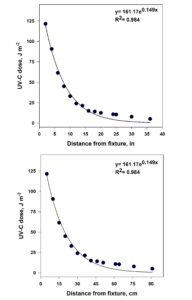
We also established a dark room in the seedling greenhouse to place the UV-light chamber in it and expose seedlings before transferring them to the main growing area (Fig. 2).
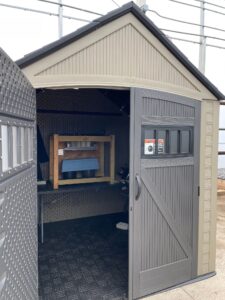
In October 2022, a preliminary test was conducted on lettuce plants that were planted in growing pots. This trial was carried out in a small scale to observe the operation of developed system before running the main trial. For this purpose, lettuce seeds were seeded in a transplant tray and kept for three weeks in the seedling greenhouse. Lettuce leaves were inoculated with powdery mildew spores 48 hours before treating the leaves with the UV-C light. Twelve infested lettuce seedlings were selected, six of them treated with UV-C light with an intensity of 140 J/M^2 for five seconds and six nontreated seedlings were served as the control. Seedlings were transplanted in growing pots including potting mix 24 hours post UV-light exposure. Three weeks after transplanting, we measured the fresh yield of lettuce. The preliminary results demonstrated that the plants treated with the UV-C light produced 45% more yield in comparison with non-treated plants (Fig. 3).
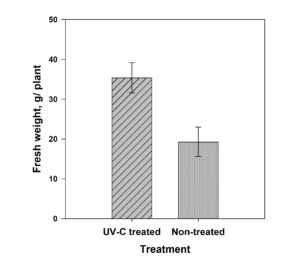
In January 2023, the second phase of this research started with planting 1,500 lettuce seeds (variety Salanova) in seedling trays. A factorial arrangement based on randomized complete block (RCBD) was designed to implement two groups of treatment in a greenhouse:
A. UV-Light Treatments:
1) exposing seedlings to UV-C light (λ = 100-279 nm) for 5 seconds at the intensity of 150 J/M2
2) exposing seedlings to UV-B light (λ = 280-314 nm) for 10 minutes,
3) exposing seedlings to UV-C (for five seconds) and UV-B (for 10 minutes) together, and
4) untreated control (no exposure to UV light)
B. Application of MilStop
Treated plots Vs. untreated control plots (28 g of MilStop will be mixed with 2.5 gallons of water and the solution will be sprayed on plants twice with a two-week interval during the growing season of lettuce).
In January 2023, four rows of planting bed were prepared in a greenhouse, soil samples were taken for analysis. The schematic map of the trial and the layout of treatments are presented in figure 4.
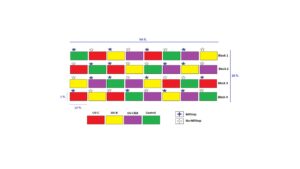
As described in the method section, a solution containing powdery mildew was prepared, and the spore count per milliliter was measured using a cytometer. The plants were then infested with these spores and treated with UV lights before being transplanted into the greenhouse (refer to Fig. 5). Thirty-five days after transplanting the seedlings in the greenhouse, we harvested the crop and evaluated the yield.
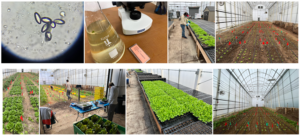
The combined results from three temporal replications of this trial demonstrate the significant effect of MilStop on lettuce yield. We observed a higher yield in all plots treated with the OMRI-listed fungicide compared to the untreated plots. The highest yield was observed in the plots treated with both MilStop and UV-C. On average, we measured approximately a 46% increase in yield in these plots compared to the non-treated control units. Figure 6 illustrates the crop yield among the various treatments.

In addition to yield, the results also showcased the impact of treatments on powdery mildew infestation levels in the greenhouses. We graded the infestation levels of lettuce plants on a scale from zero to five, where zero indicated no signs of powdery mildew, and five indicated 100% coverage of the leaf surface by powdery mildew. The highest average powdery mildew infestation was observed in the control unit, averaging 2.17. This measure was notably lower, at 0.78 and 0.94 respectively, for plots treated with UV-C/MilStop and UV-C&B/MilStop (Fig. 7).
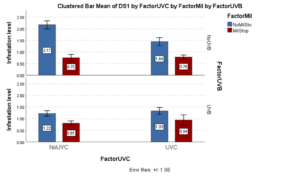
The observed increase in yield and reduced infestation levels in plots treated with UV-C and MilStop suggests that the application of these treatments can assist growers in achieving higher yields with improved marketability.
As previously mentioned, plant tissues were sampled, and mineral content analysis was performed to measure the concentrations of various macro- and micronutrients. The analysis revealed no significant effects of the treatment on the mineral content of lettuce leaves. The analysis of variance also showed that the tested treatments did not significantly influence the concentrations of the two primary monosaccharides, glucose and fructose, or the content of the primary measured secondary metabolite, Vitamin C. However, the total amino acid content in the leaves, including various essential and non-essential amino acids, was significantly affected by UV-B light. The graphs and detailed averages of minerals, vitamin C, and amino acids were presented in a manuscript currently under review by the assigned reviewers of the Horticulturae Journal.
The partner grower for this research also collected greenhouse temperature and moisture data throughout the duration of the project, which is visualized and presented in Fig. 8.
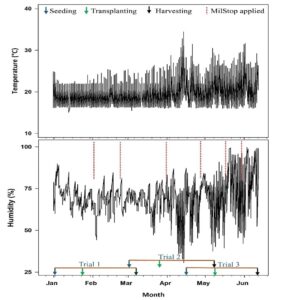
The results of this research demonstrate that integrating UV light treatments with potassium bicarbonate applications can increase crop productivity by approximately 50% while significantly reducing powdery mildew spores on leaves, enhancing marketability. This promising impact could encourage growers to adopt this methodology in their agroecosystems. However, while the interaction between these treatments shows potential, further research is needed to optimize this disease suppression strategy.
Our findings highlight that innovative disease management methods can improve crop yield without affecting mineral composition or vitamin content. The observed increase in amino acid content, coupled with improved management of microbial diseases, underscores the efficacy of environmentally sound treatments. In regenerative organic agriculture, where chemical pesticide use is prohibited, developing integrated pest and disease management approaches is critical to linking soil and environmental health with food and human health.
This research also emphasizes the positive role of UV light in greenhouse disease management while acknowledging potential risks to operators. Developing automated devices and comprehensive safety protocols for UV light application remains a priority.
All project goals were achieved, and at least two operations have begun adopting UV light applications for fungal disease management. Expanding this approach to other crops, diseases, and pests is essential, and new research projects are already planned. Grower training will continue beyond the project’s lifespan, with several educational events scheduled. Additionally, a short instructional video on using UV light for powdery mildew management is in production.
Education & outreach activities and participation summary
Participation summary:
For this research, we conducted intensive outreach activities. These included integrating UV-light application as new content for Rodale Institute Farmer and Veteran Training classes and presenting the results at several events listed below:
- Ghalehgolabbehbahani, A., Zinati, G., Dhakal, M. and Panday, D. Application of Ultraviolet Light and MilStop to Restrict Powdery Mildew Infestation in Organic Vegetable Greenhouses. ASA, CSSA & SSSA International Annual Meeting. St. Louis, MO, USA, Nov 01, 2023. (Oral presentation).
- Ghalehgolabbehbahani, A. 2023. Control pest and diseases in vegetable greenhouses with the use of UV-light. 2023 Tri-State IPM Workshop, 19 & 26 January 2023, VT, ME & NH.
- Ghalehgolabbehbahani, A. and Panday, D. 2023. RIFT lecture on “specialty crop production and pest management in regenerative organic agroecosystems” in June 2023.
- Ghalehgolabbehbahani, A. and Panday, D. Application of UV-light to control diseases in vegetable greenhouses. Rodale Institute 1st Annual Specialty Crop Symposium. Pocono, PA, August 23, 2023.
- Ghalehgolabbehbahani, A. 2023. Application of ultraviolet light and MilStop to restrict powdery mildew infestation in organic greenhouses. 2023 Northeast Integrated Pest Management Research Update Conference. November 16, 2023. (2023 Northeast Integrated Pest Management Research Update Conference - Day 2 - Northeastern IPM Center (northeastipm.org).
- Bhusal, N., Panday, D. and Ghalehgolabbehbahani, A. 2023 & 2024. Presented the UV-light project at the 2023 and 2024-Rodale Institute field day. Number of attendees: ~1000
- Bhusal, N., Panday, D. and Ghalehgolabbehbahani, A. 2023. Ultraviolet Light to Control Powdery Mildew in Vegetable Greenhouses. Pocono Organics website as Educational Material.
A special webinar was hosted by scientists at the Rodale Institute titled Application of UV Light for Integrated Pest and Disease Management in Northeast Agroecosystems. We invited three other scientists and faculty members working on UV light for related purposes to participate. The webinar attracted over 110 registrants, and a one-hour video of the event has recently been uploaded to YouTube [link provided below].
Webinar: Using UV Light to Manage Pests and Diseases in Organic Agriculture
During the webinar, we discussed topics such as managing insects like thrips and aphids with UV light and controlling powdery mildew. As a result of this event, we established a new collaboration with faculty at the University of Vermont to launch a project and develop a new interdisciplinary research proposal on this topic. We were also contacted by a grower from California, producing over 1.5 billion seedlings annually, who expressed interest in adopting similar technology to treat seedlings for downy mildew management. This highlights the significant impact of our research, which extended beyond the Northeast region and gained recognition at the national level.
In addition, two publications have been prepared from this project:
- Ghalehgolabbehbahani, A., Zinati, G., Hamido, S., Dhakal, M., Afshar, R. K., Contina, J. B., Caetani, R., Bhusal, N., Smith, A. and Panday, D. (2024). Integrated control of powdery mildew using UV-light exposure and OMRI-certified fungicide for greenhouse organic lettuce production. Horticulturae Journal. Under review.
- Ghalehgolabbehbahani, A., Contina, J.B., Dhakal, M., Smith, A. and Panday, D. (2024). Integrated Disease Management Strategy to Enhance Microgreen Production in Regenerative Organic Systems – Rodale Institute. Web Article, Rodale Institute Science Page.
The second publication resulted from an additional complementary component added to this project by the decision of the research team, demonstrating that we went beyond the original scope of work. Furthermore, we developed a safety protocol for using UV light, which was explained to operators before they began working with the equipment. This protocol will need to be finalized once commercial UV lamps become available for grower use.
Note: All our information products (publicly available and currently under review) include proper acknowledgement of SARE's support.
Learning Outcomes
The topics that we educated people on:
- Integrated approaches to control pest and diseases in organic agroecosystems
- OMRI listed products
- Organic and regenerative organic agriculture
- Environmental impact of chemical pesticides and fertilizers
- Application of UV-light to control microbial infestation in agricultural production systems
- Application of MilStop (an OMRI listed fungicide) to control fungal disease on vegetables
- National Organic Program (NOP)
- Soil and ecosystem health
- Agrobiodiversity
- Lettuce and microgreen production in regenerative organic greenhouses
- The importance of following the safety protocols on using UV light
Project Outcomes
Managing pest and diseases is one of the main challenges that organic growers face in their food production systems. Pocono Organic farmers manage ~45,000 sq. ft of certified regenerative organic greenhouse space. Since we started this project, they adopted application of MilStop and UV-light to control microbial diseases in a wide range of products. MilStop application has been using to control fungal diseases on different type of vegetables in Pocono Organic's greenhouses and fields.
Microgreens is well known as one of the most popular Pocono Organics products that can be used in Pocono Organics café or sold directly to wholesale and retail customers. Pocono Organic's farm manager reported the microbial diseases as the main restriction factor to scale up the microgreen production. Promising results collected from the preliminary test, encourage them to apply UV-C light to improve the yield of microgreen produced from broccoli seeds. Based on recommendations provided by Rodale Institute scientists, they integrated the application of UV-light with Trichoderma harzianum application. The preliminary data collected from the test illustrated that UV-light and T. harzianum have a significant effect on the yield of broccoli microgreen. Up to 200% increase in fresh yield was observed in the trays treated by T. harzianum and UV-light in comparison with the control units.
The key success of this project was identifying the problem and proposing an approach to solve it through collaboration with our partner growers. Involving the growers in the research and maintaining strong communication throughout the project facilitated its progress. One challenge we faced was the insufficient number of infested plants in the germination room for our research. To address this obstacle, we introduced powdery mildew spores extracted from the established lab culture to infest the plants. This adjustment in our methodology enabled us to address the research questions we had formulated. Based on the promising results observed, our team plans to conduct further investigations into the application of UV light across a wide range of crops and diseases. Interactions with growers and recognizing the needs within organic agroecosystems have motivated us to continue this research in the future. The next phase involves combining UV-light application with other OMRI-listed products and testing them across various specialty crops in greenhouse settings. Additionally, we aim to integrate these integrated pest and disease management strategies with emerging technologies like robotics and machine learning. This integration seeks to develop user-friendly equipment for implementing environmentally friendly pest and disease management practices in agroecosystems, thereby minimizing risks for human operators and workers.